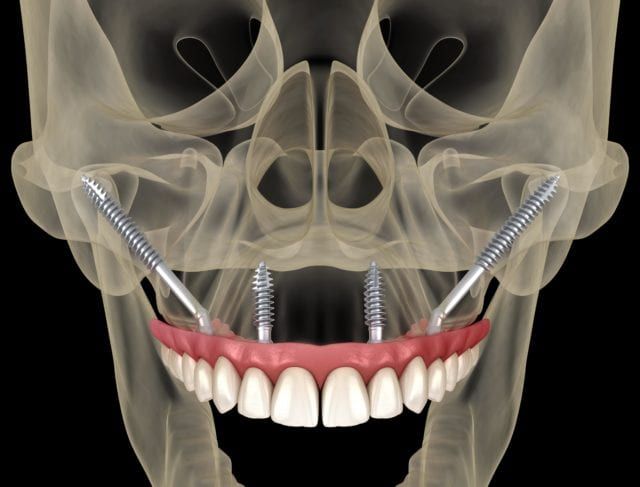If you have suffered bone loss in the upper jaw, your dentist may recommend zygomatic implants. This Swedish surgical technique uses extra long dental implants that are placed in both the jaw and cheek (zygomatic) bones. Since the implant is ultimately anchored to the cheek bone, zygomatic implants can safely be placed in patients who have undergone bone loss due to missing teeth and/or severe periodontal disease.
When having zygomatic implants placed, it is important to know what you should expect during and immediately after the procedure. For starters, being familiar with the procedure and immediate aftercare can help you decide if zygomatic implants are right for you. Additionally, knowing what to expect can resolve any excess anxiety you may have about the procedure. While everyone’s individual experience can vary slightly, here are some of the basics on what you should expect when having zygomatic implants placed:
During the Procedure

One main benefit of zygomatic implants is that they don’t require any additional procedures like bone grafts or sinus lifts. This is because the cheek bones don’t lose bone mass like the jawbones, therefore there is no need to build up bone mass before placing a zygomatic implant. Additionally, any remaining natural teeth can be extracted during the same appointment as zygomatic implants are placed. As a result, you will only need to undergo a single procedure to have your zygomatic implants placed.
When you have zygomatic implants placed, your dentist will use dental sedation and anesthetics to keep you calm and pain-free during the procedure. In many cases, you can expect to be completely asleep during the procedure. While you sleep, your dentist will make a tiny incision in your gums to reach the jawbone. They will then drill into your jaw and cheek bone to make room for the implant. Zygomatic implants are generally placed to start around the upper bicuspids and are angled to continue next to the sinus cavity until they reach the zygomatic bone.

In most cases, 1-2 zygomatic implants are placed in coordination with 2-4 traditional dental implants. However, some cases can require the placement of 4 zygomatic implants. A single zygomatic implant is equivalent to about 3-4 traditional dental implants, so the number of zygomatic implants needed will depend on the extent of bone loss that has occurred. Once all the implants have been placed, your dentist will attach the abutment pieces to both the zygomatic and traditional implants. If necessary, the gum tissue will then be sutured around these abutments.
The final step when placing zygomatic implants is to have your artificial teeth placed. When having your entire upper arch restored, you can expect to have an implant-supported denture placed. This denture will be temporary until osseointegration has occurred and will be replaced in about 4-6 months. While wearing your temporary denture, be sure to keep notes on possible adjustments you would like to make for your permanent restoration.
Immediately After the Procedure
After your procedure, you will remain in our office briefly until you regain consciousness and can safely walk on your own. Before leaving, you will need to have a driver present who can also monitor you throughout the day. Since zygomatic implants are placed in a single procedure with minimal trauma to surrounding structures, they do not usually cause too much pain. With that being said, however, it is common to experience minor discomfort, pain, swelling, bruising, tenderness, and weakness in the days immediately following your procedure. In most cases, your pain can generally be managed with over the counter pain medications. Your dentist may also give you antibiotics to take as directed in order to prevent infection. Once you have regained enough consciousness, you will be released from our office to start the recovery process.

